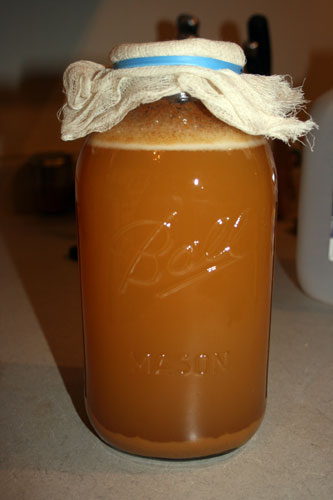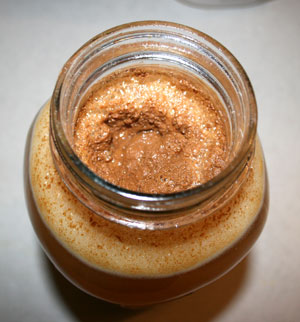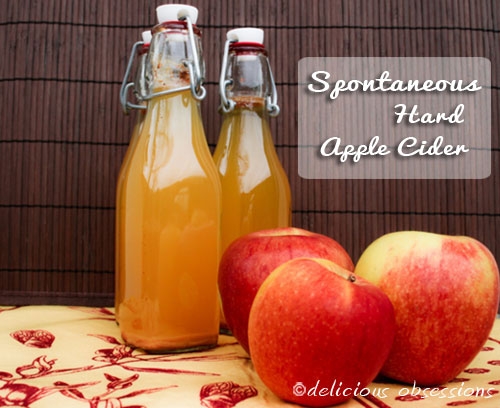FTC Disclosure: Delicious Obsessions may receive comissions from purchases made through links in this article. As an Amazon Associate I earn from qualifying purchases.Read our full terms and conditions here.
Welcome to week 4 of the 52 weeks of bad a** bacteria series! I hope you have enjoyed the posts so far. What fun ferments are going on in your kitchen? I hope you have been inspired to join me on my journey to eat more probiotic foods. I know I’ve been having a blast and it really has helped me focus on getting more probiotics into my gut.
This week, I decided to try one of Sandor Katz’s recipes from Wild Fermentation. And, believe me when I say this is the simplest fermented recipe you’ll ever try! The term apple cider is most commonly used to refer a non-alcoholic juice blend made from apples. It is usually cloudy, unlike filtered apple juice, which is clear. The cloudiness comes from the bits of apple pulp that are left in the juice. The best apple cider will be unpasteurized and kept in the refrigerated sections of the grocery store. Many places only sell it seasonally since it has a very short shelf life.
The term hard cider, or cyder, refers to the alcoholic drink made from fermented apples. The flavor and alcohol levels will vary, depending on the types of apples used and the amount of fermentation time. Wikipedia says:
“Conventional apple cider has a relatively high concentration of phenolics, namely hydroxycinnamic acid derivatives, monomeric and oligomeric flavan-3-ols, dihydrochalcones and flavonols, andantioxidants which may be helpful for preventing heart disease, cancer, and other ailments. This is, in part, because apples themselves have a fairly high concentration of phenolics.”
During the Colonial Period of the United States, apple cider was the most common beverage consumed with meals because the water was unsafe to drink. They had a mildly alcoholic version called Ciderkin that was given to children. It was made from the dregs of stronger apple cider and was very weak. Sometimes ginger or molasses would be mixed in.
Before this little experiment, I had no idea that cider was such a fascinating drink. Wikipedia has an extensive entry about what constitutes cider in various parts of the world. If you’re at all interested in this fermented apple drink, I recommend checking out Wiki’s full post.
Like I said before, this really is the simplest fermented beverage you’ll ever make. All you need is one jug of unpasteurized apple cider, some cheesecloth, and a few days.
Spontaneous Apple Cider
from Wild Fermentation
You need:
- FRESH apple cider (not pasteurized)
- Cheesecloth
- Rubber band

Get the best quality apple cider you can find. Better yet, if you have a juicer and access to organic apples, juice your own. Apples have been ridiculously expensive recently, so I didn’t have access to fresh apples for juicing. Thankfully, we have a local source for apple cider from Delicious Orchards, which is located in the North Fork Valley area of Colorado. The brand of cider that they sell at my local Vitamin Cottage is called Big B’s.
If you can’t juice your own, then check your local health food store. They should sell fresh cider in either 1/2 gallon or gallon jugs. If it’s in a glass jug, all you need to do is bring it home, take off the lid, put some cheesecloth and a rubber band over the mouth of the jar and leave it alone. If it’s in a plastic jug, you’ll need to transfer it into a glass container. Cover with the cheesecloth and rubber band. Big B’s comes in a plastic jug, so I poured mine into a glass mason jar.
Once you secure the cheesecloth, leave the cider out at room temperature for 5-7 days. I just sat mine on my kitchen counter off to the side where it wouldn’t be disturbed. Check the cider daily for mold. If you get little flecks of white mold, just gently skim them off the top. Also, taste the cider daily so you can really see how the taste changes. I would just take a clean straw and gently insert it under the foam and sip.
The fermentation process will vary depending on the temperature of your kitchen. My house stays at 68 degrees and this is how my fermentation process went:
Day 1 – The pulp settled on the bottom. No activity. Sweet and fresh tasting.
Day 2 – Not much activity. Still smelled and tasted like sweet apple juice.
 Day 3 – A tan foam appeared on the surface about an inch thick. Some of the brown pulp rose and settled on top of the foam. Still tasted sweet, but had a very faint yeasty smell. I had a few flecks of white mold, each about the size of a grain of sand, which I gently skimmed off the top. Bubbles of carbonation were starting to appear along the sides of the jar. The two pics in this post were from day 3.
Day 3 – A tan foam appeared on the surface about an inch thick. Some of the brown pulp rose and settled on top of the foam. Still tasted sweet, but had a very faint yeasty smell. I had a few flecks of white mold, each about the size of a grain of sand, which I gently skimmed off the top. Bubbles of carbonation were starting to appear along the sides of the jar. The two pics in this post were from day 3.
Day 4 – The foam remains. The yeasty smell was much stronger and the cider tasted faintly like wine. Still sweet, but not as sweet as Day 3 and very lightly fizzy. Two teeny, tiny flecks of mold that I skimmed off.
Day 5 – Foam remains. Strong yeasty smell and the cider was only slightly sweet, yet mildly tart. Very fizzy and refreshing. I decided to bottle it at this point.
The thing that I found so fascinating about this process was how quickly things changed from one day to another. When I went to bed on Day 2, there was no foam, but when I woke up on Day 3, there was a thick layer of foam on the top. On Day 4, the juice was still pretty sweet, but by Day 5, the sweetness was very faint. You could leave it longer, but I decided to bottle after Day 5 because I didn’t want it to get too tart.
I bottled the cider in the same flip top bottles that I used for my kombucha. After I bottled the cider, I left them out at room temperature (in a covered box, just in case something exploded) for 2 days and then moved to the fridge. Just like your kombucha, the juice will slowly continue to ferment as it ages, so the flavor will change a little. The beverage is very refreshing and mildly alcoholic, so enjoy in moderation. I just bought a hydrometer to test the alcohol levels in my fermented beverages, but I have not gotten around to testing this one yet. I will update this post when I do.
So, tell me. Have you made hard apple cider before? How about wine, mead, or beer? I personally am having so much fun with these fermentation projects and I can’t wait to keep experimenting!


104 Comments